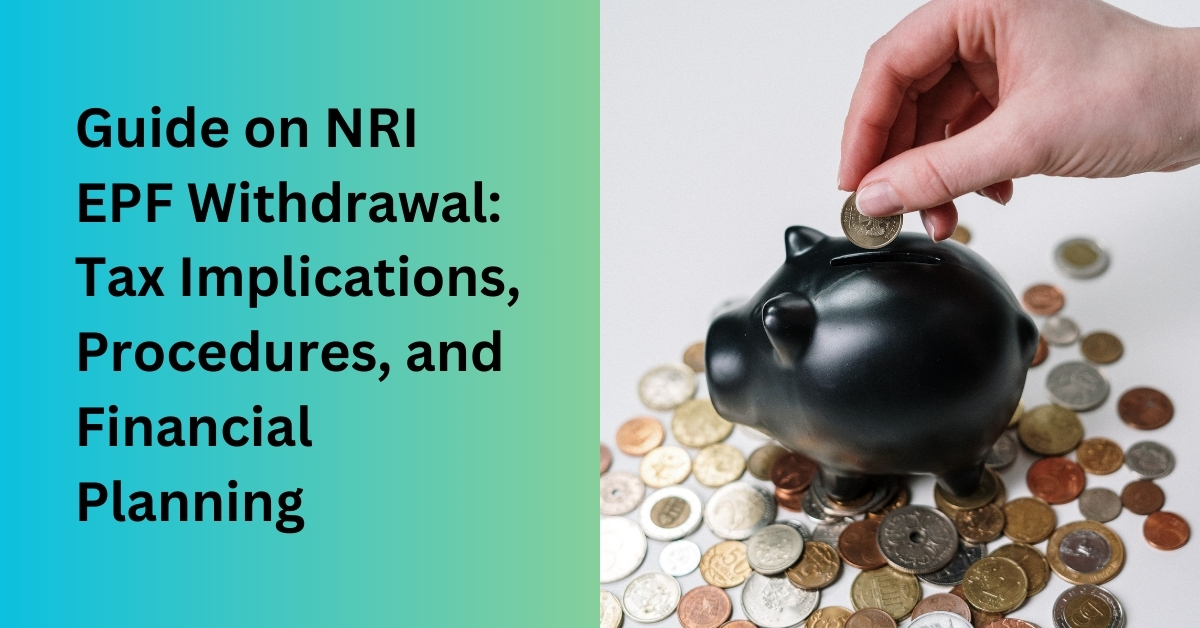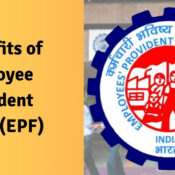Guide on NRI EPF Withdrawal: Tax Implications, Procedures, and Financial Planning
Relocating out of India for better career prospects and an improved lifestyle is a joint decision many business professionals and employees make. This significant step often brings financial considerations to the forefront. One of these considerations is what happens to your Employee’s Provident Fund (EPF) account as a Non-Resident Indian (NRI). This guide aims to provide a detailed overview of NRI PF withdrawal, including tax implications, procedures, and financial planning tips.
Understanding the Employee Provident Fund (EPF)
The Employee Provident Fund (EPF) is a retirement savings scheme in India, mandatorily contributed by both the employer and the employee. It is regulated by the Employees’ Provident Fund Organization (EPFO) and aims to provide financial security post-retirement. Over the years, an employee’s contribution, along with that of the employer and accrued interest, can result in a substantial corpus, providing a significant nest egg for the future.
EPF Account for NRIs: Eligibility and Withdrawal Rules
Eligibility of NRI Investments in EPF
While residing and working in India, employees contribute a portion of their salary towards their EPF account. Suppose they become Non-Resident Indians (NRIs) after leaving the country for employment purposes. In that case, they can no longer contribute to the EPF account as per the Employees’ Provident Fund Act. However, the EPF balance can be withdrawn under specific conditions before retirement.
Rules of EPF Withdrawal for NRIs
Under typical circumstances, EPF withdrawals can be made after the employee turns 58, upon retirement, or if the employee has been unemployed for over two months. For NRIs relocating abroad, a special provision allows for immediate withdrawal of the entire EPF balance, including the contributions made by both the employee and employer and the accrued interest.
Utilizing the Online Portal for EPF Withdrawal
Suppose the Universal Account Number (UAN) is linked with the employee’s Aadhaar. The EPF withdrawal can be initiated online via the UAN member unified portal or the UMANG App. This process involves filling in the necessary details, uploading supporting documents, and submitting the form for verification.
- Online Portal and UMANG App: Use the UAN member unified portal or the UMANG App to apply for EPF withdrawal.
- Proof of Abroad Settlement: Submit proof of intention to work or settle abroad, such as a visa, passport, and employment offer letter.
Offline Process for EPF Withdrawal
For those preferring the offline route:
- EPF Withdrawal Form: Obtain the form from the employer or download it from the EPFO portal. (https://unifiedportal-mem.epfindia.gov.in/memberinterface/)
- Form Submission: Complete and submit the form to the local EPFO office, along with self-attested copies of the required documents. The reason for leaving the job should be “Abroad Settlement.”
- Employer Endorsement: If the UAN is not linked with Aadhaar, endorsement from the employer is required before applying at the EPFO office.
Documents Required for EPF Withdrawal
To facilitate the withdrawal process, ensure you have the following self-attested copies of documents:
- Aadhaar Card for identity verification
- Proof of date of birth
- Local Indian address proof
- Certified copy of the EPF passbook if UAN is not allotted
- Proof of date of exit from last employment
- Bank details with IFSC code (cancelled cheque)
- PAN Card
- Marriage certificate (for female members only, if previously unmarried)
Temporary Relocation Abroad
Suppose the relocation is temporary, and there is a plan to return and resume employment in India. In that case, it’s essential to preserve the EPF balance. The account remains operative for three years, earning interest during this period. Upon return, the balance can be transferred to a new EPF account using the UAN. Inoperative accounts need to be updated at local EPFO offices.
Taxability of PF Withdrawal for NRIs
Tax Implications on EPF Withdrawal
For NRIs, understanding the tax implications is crucial. EPF withdrawals are tax-free if withdrawn after five years of continuous service. However, TDS (Tax Deducted at Source) applies for withdrawals before completing five years. The taxability is also influenced by whether the PF account is linked to a valid PAN and the specific tax treaties between India and the NRI’s country of residence, known as the Double Taxation Avoidance Agreement (DTAA).
Tax Scenarios for EPF Withdrawal
Withdrawal Before 5 Years
- Amount Less Than ₹50,000: No TDS. However, if the individual falls under the taxable bracket, they must declare the PF withdrawal in their income tax return.
- Amount More Than ₹50,000: 10% TDS if PAN is linked; 30% TDS if PAN is not provided.
Withdrawal After 5 Years
No TDS is deducted if the withdrawal is made after five years of continuous employment.
Temporary Employee Tax on PF Withdrawal
Temporary employees or those on contract who resign before completing five years of continuous service, even if the total employment duration includes months not on permanent rolls, will have TDS withheld from their EPF withdrawal as the five-year term is not considered complete.
Important Tax Considerations for NRIs
- TDS Rates for Non-Residents: TDS is deducted at 30% under Section 195 of the Income Tax Act. However, if the Double Taxation Avoidance Agreement (DTAA) specifies a different rate that benefits PF members, that rate will be applied instead.
- Surcharge and Cess: A 4% cess on the TDS amount and a surcharge apply to non-residents. However, these do not apply if TDS is deducted according to DTAA provisions.
Surcharge Rates for NRIs’NRIs’ Interest Income
For the FY 2023-24, the applicable surcharge rates on NRIs’NRIs’ interest income are specified below:
- Interest income below ₹50 lakh – No Surcharge
- Interest income above ₹50 lakh to ₹ one crore – 10%
- Interest above ₹1 crore to ₹2 crore – 15%
- Interest above ₹2 crore to ₹5 crore – 25%
- Interest above ₹5 crore – 37%
Claiming DTAA Benefits
To take advantage of DTAA benefits, a member must obtain a Tax Residency Certificate (TRC) by filing Form 10F with the income tax department. Once the application in Form 10F is submitted, the Assessing Officer may issue a TRC in Form 10FB. With this TRC, the non-resident member can benefit from the provisions of double taxation avoidance.
Taxation on Interest from Excess PF Contribution
If the EPF and VPF contributions exceed ₹2.5 lakh during the financial year, TDS must be deducted from the interest accrued on the taxable portion of the PF contribution. However, the interest accrued on the carried forward balance of a non-taxable account will remain tax-exempt.
EPF Interest Rate for FY 2023-24
The interest rate of EPF for the FY 2023-24 is 8.25%.
Utilizing EPF for Property Investments Abroad
While the EPFO allows withdrawal from the EPF account for the purchase or construction of a house or flat in India, NRIs cannot directly redeem EPF money to buy a home outside India. However, there are lawful ways to utilize these funds for international property investments after meeting the withdrawal criteria:
- Regular Withdrawal and Remittance: Withdraw the EPF funds and remit them through legal banking channels to the country of residence for property investment.
- Investment through NRE/NRO Accounts: Transfer EPF amount to NRE (Non-Resident External) or NRO (Non-Resident Ordinary) accounts, which can be used to invest in properties outside India.
Tax Implications of International Property Investments
NRIS must understand the tax implications of withdrawing EPF funds and remitting abroad. While EPF withdrawals after five years of continuous service are tax-free in India, the amount may be subject to taxation in the NRI’s country of residence. Hence, consulting with a tax advisor familiar with India and the resident country’s tax laws is essential.
Key Takeaways for NRI PF Withdrawal
- Eligibility: NRIs can continue contributing to their existing EPF account if they contributed before attaining NRI status.
- Immediate Withdrawal: NRIs can withdraw the entire EPF balance immediately upon relocating abroad without any waiting period.
- Tax Implications: Understanding tax implications, including DTAA, is crucial to avoid double taxation and optimize financial planning.
- Documentation: Proper documentation, including proof of relocation and employment abroad, is necessary for a smooth withdrawal process.
Conclusion
Managing your EPF account as an NRI requires understanding eligibility, withdrawal procedures, and tax implications. Staying informed about EPF regulations, tax laws, and potential legislative changes is essential for maximizing the benefits of your EPF investments and securing your financial future.
By effectively managing your EPF account, you can ensure that your hard-earned savings are utilized wisely, whether to facilitate your new life abroad or to invest for greater returns. Seeking professional tax advisor advice and staying proactive in your financial planning can help you navigate the complexities of NRI EPF withdrawal and maximize your retirement savings.
This blog is for informational purposes only. The information here does not represent legal advice and should not be used as such. Please confirm the accuracy of any data or content from reliable sources on your own.
FAQs on NRI PF Withdrawal
1. What is the Employee Provident Fund (EPF)?
– The Employee Provident Fund (EPF) is a retirement savings scheme in India, where both the employer and employee contribute a portion of the employee’s salary. It is regulated by the Employees’ Provident Fund Organization (EPFO) and aims to provide financial security after retirement.
2. Can NRIs continue to contribute to their EPF account after relocating abroad?
– No, once an employee becomes a Non-Resident Indian (NRI), they can no longer contribute to their EPF account as per the Employees’ Provident Fund Act. However, the existing EPF balance can be withdrawn under specific conditions.
3. How can NRIs withdraw their EPF balance?
– NRIs can withdraw their EPF balance immediately upon relocating abroad. The withdrawal process can be initiated online through the UAN member unified portal or the UMANG App if the UAN is linked with Aadhaar. Alternatively, the withdrawal can be processed offline by submitting the required documents to the local EPFO office.
4. What documents are required for EPF withdrawal for NRIs?
The necessary documents for EPF withdrawal include:
– Aadhaar Card for identity verification
– Proof of date of birth
– Local Indian address proof
– Certified copy of the EPF passbook (if UAN is not allotted)
– Proof of date of exit from last employment
– Bank details with IFSC code (cancelled cheque)
– PAN Card
– Marriage certificate (for female members only, if previously unmarried)
5. What are the tax implications of EPF withdrawal for NRIs?
– EPF withdrawals are tax-free if withdrawn after five years of continuous service. For withdrawals before completing five years, TDS (Tax Deducted at Source) applies. The taxability is influenced by whether the PF account is linked to a valid PAN and the specific tax treaties between India and the NRI’s country of residence, known as the Double Taxation Avoidance Agreement (DTAA).
6. What is the TDS rate for EPF withdrawals before five years of continuous service?
For withdrawals before five years:
– Amount less than ₹50,000: No TDS.
– Amount more than ₹50,000: 10% TDS if PAN is linked; 30% TDS if PAN is not provided.
7. Can NRIs use EPF funds to invest in property abroad?
– NRIs cannot directly use EPF funds to buy property outside India. However, they can withdraw the funds and remit them through legal banking channels or transfer the amount to NRE/NRO accounts, which can then be used for property investments abroad.
8. What happens to an EPF account if an NRI plans to return to India temporarily?
– If the relocation is temporary and there are plans to return and resume employment in India, the EPF account remains operative for three years, earning interest during this period. Upon return, the balance can be transferred to a new EPF account using the UAN.
9. How does the Double Taxation Avoidance Agreement (DTAA) benefit NRIs in EPF withdrawals?
– DTAA allows NRIs to avoid double taxation on their EPF withdrawals. To claim DTAA benefits, NRIs must obtain a Tax Residency Certificate (TRC) by filing Form 10F with the income tax department. This certificate helps ensure that the tax rates specified in DTAA are applied.
10. What is the current interest rate for EPF for the FY 2023-24?
– The interest rate for EPF for the financial year 2023-24 is 8.25%.





